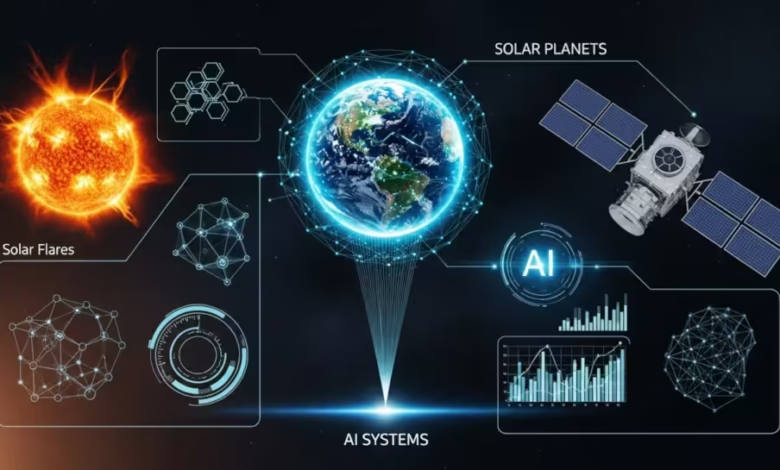AI in Space Weather Forecasting: Protecting Earth from Solar Storms

The blog post explores the significant role of AI in space weather forecasting, particularly in protecting Earth from solar storms. It explains how AI space weather technologies enhance the prediction of solar flares by analyzing vast datasets and identifying patterns that human forecasters might overlook. The article further discusses mechanisms for ensuring satellite safety during geomagnetic storms, showcasing AI’s capabilities in real-time data processing and risk assessment. By leveraging machine learning algorithms, researchers can better predict space weather events and mitigate their effects on technology and infrastructure. In conclusion, the article emphasizes the innovative advancements of AI in the realm of space weather forecasting and its potential to safeguard our planet from the impacts of solar activity.
Understanding AI’s Role In Space Weather Forecasting

The advent of AI space weather has revolutionized how scientists predict and understand the complexities of space weather phenomena. Specifically, AI technologies enable researchers to analyze vast amounts of data from solar activities, helping to forecast events such as solar flares and geomagnetic storms with a greater degree of accuracy. These predictive capabilities not only enhance our understanding of solar behavior but also play a crucial role in protecting our planet’s technological infrastructure, including satellites and communication systems, from the potentially damaging effects of solar storms.
Key Aspects of AI In Space Weather
- Enhanced data processing: AI algorithms can process enormous datasets from space observatories much faster than traditional methods.
- Pattern recognition: Machine learning models excel in identifying patterns related to solar flare prediction.
- Real-time monitoring: Utilizing AI, scientists can receive immediate updates on solar activities.
- Improved accuracy: AI models have demonstrated a higher accuracy rate in predicting solar events compared to previous forecasting methods.
- Automated alerts: AI systems can automatically trigger alerts when solar activity reaches a predefined threshold.
- Interdisciplinary approach: The integration of AI in space weather forecasting promotes collaboration across various scientific disciplines.
As AI continues to evolve, its application in space weather forecasting promises to be a game changer. With the ability to facilitate timely solar flare prediction, AI models are enhancing both understanding and preparedness for solar events that could have profound implications for life on Earth. This innovation not only aids in safeguarding technology but also contributes to the broader field of study regarding the interactions between Earth and space.
The Mechanisms Behind Solar Flare Prediction Using AI

As the importance of predicting solar flares increases, the utilization of AI space weather has become a pivotal focus in the scientific community. By leveraging advanced algorithms and extensive datasets, scientists can improve forecast accuracy and mitigate the impact of solar storms on Earth. Solar flares can trigger geomagnetic storms that disrupt satellite operations, communication systems, and even power grids. Consequently, the integration of artificial intelligence in analyzing patterns and detecting anomalies is essential to develop effective prediction systems.
Modern techniques in data analysis are crucial for understanding solar flare behavior. Researchers collect vast amounts of solar data from observatories and satellites, which encompasses historical solar activity, magnetic field measurements, and sunspot observations. To streamline the analysis, various space climate tech methods are employed, providing a comprehensive overview of solar activity trends. This analysis serves as the foundation for AI algorithms that draw insights and forecast potential solar events.
| Data Source | Type of Data | Purpose |
|---|---|---|
| Solar Dynamics Observatory (SDO) | Imaging Data | Monitoring solar features and activity |
| Advanced Composition Explorer (ACE) | Particle Data | Studying the solar wind and cosmic rays |
| Virtual Solar Observatory (VSO) | Historical Data | Analyzing historical solar activity patterns |
| Solar and Heliospheric Observatory (SOHO) | Magnetic Field Data | Assessing solar magnetic activity and coronal mass ejections |
The robustness of AI’s predictive capabilities hinges upon the specific machine learning algorithms utilized in the analysis of solar data. Various models such as neural networks, support vector machines, and ensemble methods are implemented to learn from past solar activity and predict future events. By continually refining these models with new data, researchers can enhance the accuracy of their forecasts, leading to better preparedness against impending solar storms.
Steps For Effective Solar Flare Prediction
- Gather extensive historical and real-time solar data from multiple observatories.
- Preprocess data to ensure accuracy and remove anomalies.
- Utilize advanced data analysis techniques for extracting meaningful patterns.
- Implement machine learning algorithms to train predictive models.
- Test and validate the predictive models against known solar events.
- Continuously update models with new data for improvement.
- Disseminate predictions and warnings to relevant stakeholders and the public.
The fusion of AI technology with solar flare prediction represents a promising frontier in protecting Earth’s technological infrastructure from the unpredictable behavior of the sun. As AI capabilities evolve, so too will our ability to anticipate and respond to solar events, safeguarding critical systems and contributing to our understanding of space weather.
Ensuring Satellite Safety During Geomagnetic Storms

As solar storms continue to pose a significant threat to satellite systems, ensuring satellite safety during geomagnetic storms has become a crucial endeavor for researchers and engineers alike. These storms can disrupt communications, navigation systems, and even impact the functionality of satellites in orbit. The integration of AI space weather technology plays a critical role in predicting these events and implementing strategies to safeguard satellites from potential damage.
In recent years, advancements in AI space weather forecasting have enabled scientists to better understand the dynamics of solar storms. This understanding allows for more accurate predictions of geomagnetic storm intensity and duration, resulting in better preparation for those managing satellite operations. By employing machine learning algorithms and analyzing vast datasets from solar observations, researchers can enhance the accuracy of their warnings related to solar activities, which leads to more effective protective measures for satellites.
| Storm Type | Impact on Satellites | Preventive Measures |
|---|---|---|
| Coronal Mass Ejection (CME) | High radiation levels can cause electronics to malfunction. | Activate onboard shielding and reduce power. |
| Solar Flare | Disruption of radio communications and navigation. | Monitor solar activity and adjust operational parameters. |
| Geomagnetic Storm | Increased drag on satellites can alter their orbits. | Implement orbit adjustments based on predictions. |
| Radiation Storm | Potential damage to onboard systems. | Conduct risk assessments and prepare shielding. |
To effectively protect satellite systems during geomagnetic storms, it’s essential to implement a range of impact mitigation strategies. These strategies not only focus on preemptive actions based on AI space weather predictions but also include operational adjustments that minimize storm effects when they occur. By fostering a proactive approach, satellite operators can significantly reduce the risk of damage and maintain continuous service even during solar events.
Best Practices For Satellite Protection
- Conduct regular assessments of satellite vulnerabilities.
- Utilize AI-driven forecasting models for timely storm alerts.
- Implement onboard shielding to minimize radiation exposure.
- Reduce satellite activity during predicted storms.
- Adjust orbits as necessary based on real-time space weather data.
- Collaborate with other agencies for shared knowledge and resources.
- Invest in technology upgrades for improved resilience.
Ultimately, the combination of real-time data analysis and strategic planning is essential for maintaining satellite safety during geomagnetic storms. By leveraging AI space weather advancements, stakeholders can ensure that vital satellite systems remain operational, safeguarding both communication networks and essential navigation systems for users on Earth.
Concluding Thoughts on AI Innovations For Space Weather
The rapid advancements in AI technology have ushered in a new era for space weather forecasting, particularly in the realm of solar flare prediction and the management of geomagnetic storms. By harnessing the tremendous processing power and analytical capabilities of AI, scientists can now interpret large datasets more efficiently, leading to more accurate predictions and timely responses to solar activities that could impact Earth. The implementation of AI space weather models is not just a scientific breakthrough but a crucial step toward safeguarding our technological infrastructure, which is increasingly vulnerable to solar events.
Actionable Steps To Implement AI In Space Weather Forecasting
- Invest in Comprehensive Data Collection: Ensure continuous monitoring of solar activities through satellite missions and ground-based observatories.
- Develop AI Models: Create robust machine learning algorithms that incorporate historical data for improved solar flare prediction accuracy.
- Enhance Computational Power: Equip research facilities with high-performance computing systems capable of processing large volumes of data rapidly.
- Collaborate with Industry Experts: Partner with AI experts and data scientists to refine prediction models and algorithms for real-world applications.
- Implement Real-time Alert Systems: Develop automated alert systems that can inform stakeholders promptly when a geomagnetic storm is imminent.
- Conduct Regular Training and Updates: Regularly update AI models with new data and recent findings to maintain their relevance and accuracy.
- Promote Public Awareness: Educate the general public and relevant sectors about the importance of AI in space weather forecasting and its potential impacts.
By adopting these actionable steps, the integration of geomagnetic storm AI systems into our space weather forecasting practices can be successfully realized. As we progress, it is essential to continue exploring innovative solutions and adapting our strategies, ensuring that we remain one step ahead of solar phenomena that pose a risk to technologies and infrastructure on Earth. The future of AI space weather innovation is promising, and the potential benefits are immense for both scientific research and practical applications.
Briefing Document: AI in Space Weather Forecasting
I. Summary
The provided article highlights the revolutionary impact of Artificial Intelligence (AI) on space weather forecasting, particularly in enhancing our ability to predict solar flares and geomagnetic storms, and to mitigate their effects on Earth’s technological infrastructure. AI’s core strengths lie in its ability to process vast datasets, recognize complex patterns, provide real-time monitoring, and achieve higher accuracy in predictions compared to traditional methods. This innovation is deemed a “game changer” for safeguarding critical systems like satellites and communication networks, and for advancing our overall understanding of solar-terrestrial interactions.
II. Main Themes and Key Ideas
The central themes revolve around AI’s transformative capabilities in space weather, categorized into prediction, protection, and operational enhancement.
A. AI’s Revolution in Space Weather Forecasting
AI is fundamentally changing how scientists predict and understand space weather phenomena, offering significant improvements over previous methods.
- Enhanced Data Processing & Pattern Recognition: AI algorithms can “process enormous datasets from space observatories much faster than traditional methods” and “excel in identifying patterns related to solar flare prediction.” This is crucial for analyzing the vast amount of data from solar activities.
- Improved Accuracy & Real-time Monitoring: AI models have demonstrated “a higher accuracy rate in predicting solar events compared to previous forecasting methods.” This is coupled with AI’s ability to facilitate “immediate updates on solar activities” and “automatically trigger alerts when solar activity reaches a predefined threshold.”
- Protecting Earth’s Infrastructure: The primary driver for these advancements is “protecting our planet’s technological infrastructure, including satellites and communication systems, from the potentially damaging effects of solar storms.”
B. Mechanisms Behind AI-Driven Solar Flare Prediction
The effectiveness of AI in predicting solar flares relies on sophisticated data collection, analysis, and machine learning techniques.
- Extensive Data Collection: Scientists gather “vast amounts of solar data from observatories and satellites, which encompasses historical solar activity, magnetic field measurements, and sunspot observations.” Key data sources include:
- Solar Dynamics Observatory (SDO): Imaging Data (Monitoring solar features and activity)
- Advanced Composition Explorer (ACE): Particle Data (Studying the solar wind and cosmic rays)
- Virtual Solar Observatory (VSO): Historical Data (Analyzing historical solar activity patterns)
- Solar and Heliospheric Observatory (SOHO): Magnetic Field Data (Assessing solar magnetic activity and coronal mass ejections)
- Machine Learning Algorithms: “The robustness of AI’s predictive capabilities hinges upon the specific machine learning algorithms utilized in the analysis of solar data.” This includes models such as “neural networks, support vector machines, and ensemble methods” which learn from past solar activity to predict future events.
- Continuous Improvement: Models are continually refined “with new data” to enhance forecasting accuracy, leading to “better preparedness against impending solar storms.”
C. Ensuring Satellite Safety During Geomagnetic Storms
Geomagnetic storms pose a significant threat to satellites, and AI is instrumental in predicting these events and implementing protective measures.
- Impact of Storms on Satellites:Coronal Mass Ejection (CME): “High radiation levels can cause electronics to malfunction.”
- Solar Flare: “Disruption of radio communications and navigation.”
- Geomagnetic Storm: “Increased drag on satellites can alter their orbits.”
- Radiation Storm: “Potential damage to onboard systems.”
- AI for Proactive Protection: AI advancements enable “more accurate predictions of geomagnetic storm intensity and duration,” allowing for better preparation. This involves using machine learning to “enhance the accuracy of their warnings related to solar activities, which leads to more effective protective measures for satellites.”
- Mitigation Strategies: Beyond prediction, AI informs “impact mitigation strategies” including “preemptive actions” and “operational adjustments.” Best practices include:
- Utilizing “AI-driven forecasting models for timely storm alerts.”
- Implementing “onboard shielding.”
- Reducing “satellite activity during predicted storms.”
- Adjusting “orbits as necessary based on real-time space weather data.”
D. Actionable Steps for AI Implementation in Space Weather
The article concludes with a call for strategic implementation of AI in space weather forecasting, emphasizing a proactive and collaborative approach.
- Investment in Data and Infrastructure: Requires “comprehensive data collection” and “high-performance computing systems capable of processing large volumes of data rapidly.”
- Model Development and Refinement: Focus on creating “robust machine learning algorithms” and conducting “regular training and updates” with new data.
- Collaboration and Dissemination: Emphasizes partnering “with AI experts and data scientists” and developing “automated alert systems” to inform stakeholders promptly.
- Public Awareness: Promotes educating “the general public and relevant sectors about the importance of AI in space weather forecasting and its potential impacts.”
III. Most Important Ideas/Facts
- AI is a “game changer” for space weather forecasting. Its ability to process vast datasets and recognize patterns vastly improves prediction accuracy.
- The primary motivation for AI in space weather is to safeguard Earth’s technological infrastructure, particularly satellites and communication systems, from solar storms.
- AI-driven predictions are based on analyzing diverse solar data from observatories like SDO, ACE, VSO, and SOHO, using machine learning algorithms (neural networks, support vector machines, ensemble methods).
- AI facilitates proactive measures for satellite safety, including timely alerts, operational adjustments (e.g., reducing activity, adjusting orbits), and implementing physical protections (e.g., shielding).
- Successful integration of AI requires significant investment in data collection, computational power, collaborative efforts with AI experts, and real-time alert systems.
- The future of AI in space weather is “promising” and offers “immense” benefits for both scientific research and practical applications, ensuring preparedness against unpredictable solar phenomena.
For similar articles, please visit: AI in Science & Technology
Homepage / humanaifuture.com
🎧 Listen to the Podcast
Want to explore this topic in more depth? Listen to the full podcast for more insights and expert commentary.
▶️ Play on Google DriveNo sign-up needed — just click and listen.
What are the primary threats posed by solar storms, and how does AI help mitigate them?
Solar storms, including solar flares and coronal mass ejections (CMEs), can trigger geomagnetic storms that pose significant threats to Earth's technological infrastructure. These threats include disruptions to satellite operations, communication systems, navigation systems, and even power grids. AI helps mitigate these impacts by providing more accurate and timely predictions of solar events, allowing for proactive measures. For satellites, this can involve activating onboard shielding, reducing power, adjusting operational parameters, or implementing orbit changes based on AI-driven forecasts. For ground systems, AI enables early warnings to prepare critical infrastructure.
What specific types of data does AI analyze for solar flare prediction?
AI analyzes a comprehensive range of solar data from various observatories and satellites for solar flare prediction. This includes imaging data from sources like the Solar Dynamics Observatory (SDO) to monitor solar features and activity, particle data from the Advanced Composition Explorer (ACE) to study solar wind and cosmic rays, and magnetic field data from the Solar and Heliospheric Observatory (SOHO) to assess solar magnetic activity and CMEs. Additionally, historical data from sources like the Virtual Solar Observatory (VSO) are crucial for analyzing past solar activity patterns, allowing AI models to learn and predict future events.
What machine learning algorithms are used in AI space weather forecasting?
Various machine learning algorithms are utilized in AI space weather forecasting to analyze solar data and predict future events. These include neural networks, which are particularly adept at recognizing complex patterns; support vector machines, which are powerful for classification and regression analysis; and ensemble methods, which combine multiple models to improve predictive performance and robustness. These models are continuously refined with new data to enhance the accuracy of solar event forecasts.
How does AI ensure the safety of satellites during geomagnetic storms?
AI ensures satellite safety during geomagnetic storms by providing accurate predictions of storm intensity and duration, enabling proactive measures. Based on AI-driven forecasts, satellite operators can implement various impact mitigation strategies. These include activating onboard shielding to minimize radiation exposure from events like Coronal Mass Ejections, monitoring solar activity and adjusting operational parameters to counter disruptions from solar flares, implementing orbit adjustments to compensate for increased drag during geomagnetic storms, and conducting risk assessments for potential damage to onboard systems during radiation storms.
What are the key steps involved in effective solar flare prediction using AI?
Effective solar flare prediction using AI involves several key steps. First, extensive historical and real-time solar data from multiple observatories must be gathered. This data is then preprocessed to ensure accuracy and remove anomalies. Next, advanced data analysis techniques are employed to extract meaningful patterns. Machine learning algorithms are then implemented to train predictive models using this data. These models are rigorously tested and validated against known solar events and continuously updated with new data for ongoing improvement. Finally, predictions and warnings are disseminated to relevant stakeholders and the public.
What is the broader impact of AI innovation in space weather forecasting?
The broader impact of AI innovation in space weather forecasting is significant and far-reaching. It represents a crucial step toward safeguarding our increasingly vulnerable technological infrastructure, including satellites, communication systems, and power grids, from the unpredictable behavior of the sun. Beyond protecting technology, AI enhances our fundamental understanding of solar behavior and the complex interactions between Earth and space. This innovation promotes an interdisciplinary approach, fostering collaboration across various scientific fields and ensuring better preparedness for solar events that could have profound implications for life on Earth.
What actionable steps are crucial for successfully integrating AI into space weather forecasting practices?
Successfully integrating AI into space weather forecasting practices requires several actionable steps. These include investing in comprehensive data collection through continuous monitoring of solar activities, developing robust AI models with machine learning algorithms that incorporate historical data for improved accuracy, and enhancing computational power in research facilities. It also involves collaborating with AI experts and data scientists to refine models, implementing real-time automated alert systems for imminent geomagnetic storms, regularly updating AI models with new data, and promoting public awareness about the importance and impact of AI in space weather forecasting.




